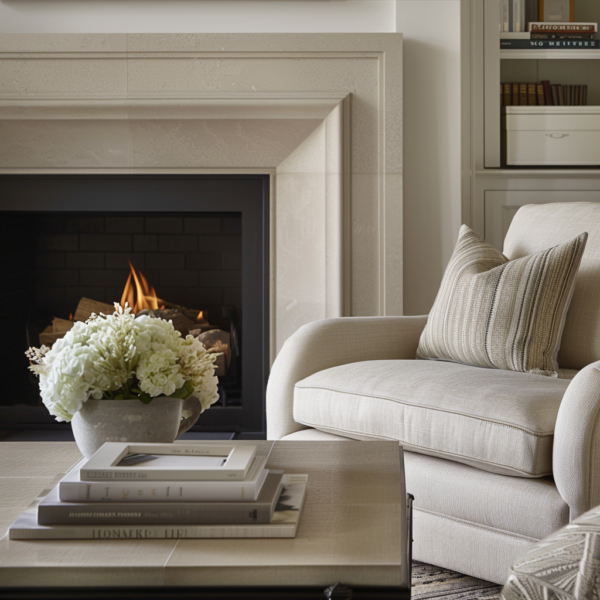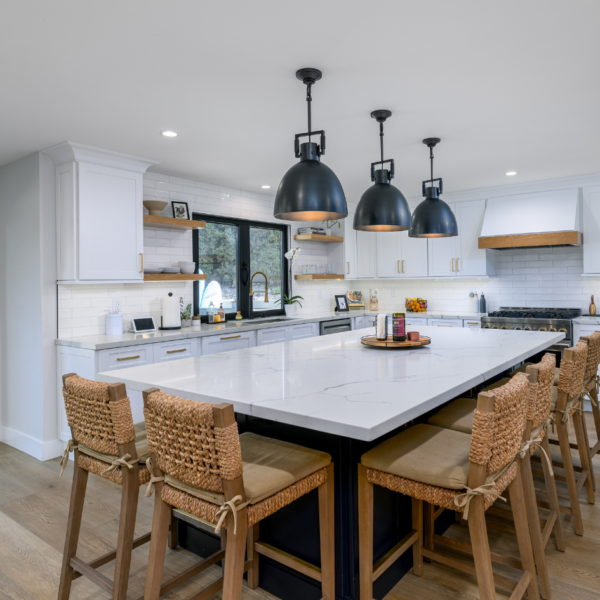Choosing the right cabinetry is one of the most important decisions in any kitchen or bathroom remodel. Cabinets not only define the aesthetic of the space, but they also impact functionality, storage, and overall durability. With so many options available, understanding cabinetry construction, styles, and customization levels can help you make an informed decision that suits your needs and budget. From molding options and finished ends to hardware placement and construction type, every decision impacts the final look and usability of your kitchen. Let’s dive into what makes cabinet selection so important and the key elements you should consider before making your choice.
To make the process even easier, download our Cabinet Selection Guide for a condensed version of this post, featuring key takeaways and inspiration for your next project!
Cabinet Construction: Framed vs. Frameless
Framed Cabinetry
Framed cabinets are a classic choice, especially popular in traditional and transitional styles. These cabinets have a face frame attached to the front of the cabinet box, which provides extra strength and stability. The doors attach to this frame, creating either an inset, partial overlay, or full overlay look.
- Pros: Sturdier construction, a wide range of styles, and a more traditional appearance.
- Cons: Slightly reduced interior space due to the frame, especially with inset doors.

Frameless Cabinetry
Also known as European-style cabinetry, frameless cabinets eliminate the face frame, allowing for a sleek, modern look with full access to the interior. The doors attach directly to the cabinet box, offering a seamless and contemporary aesthetic.
- Pros: Maximized storage space, modern design, and easier access.
- Cons: Requires precise installation due to tighter tolerances, typically a higher price point.

Stock vs. Semi-Custom vs. Custom Cabinetry
Stock Cabinets Stock cabinets are pre-manufactured in standard sizes and finishes. They are mass-produced, which makes them an affordable and readily available option. While stock cabinets come in a variety of styles, they have limitations in terms of customization. Homeowners looking for quick installation or working within a tighter budget often opt for stock cabinetry.
- Pros: Most affordable and short lead time, great for vanities and smaller spaces
- Cons: Limited styles, sizes and configurations, minimal customizations if any, typically lower-grade materials

Semi-Custom Cabinets
Semi-custom cabinets offer a balance between affordability and personalization. These cabinets are factory-made but allow for modifications in size, finishes, and some design elements. They are a great choice for homeowners looking for flexibility without the cost of full customization.
- Pros: More design options than stock cabinetry, cost-effective compared to fully custom cabinets.
- Cons: Limited modifications compared to fully custom cabinetry.

Custom Cabinets
For homeowners who want complete control over their cabinetry, custom cabinets are the ultimate solution. These cabinets are built to order, offering limitless options in terms of materials, finishes, dimensions, and unique design features.
- Pros: Tailored to your exact specifications, high-quality craftsmanship, and unique design possibilities.
- Cons: Higher cost and longer lead times due to the bespoke nature of construction.
Once you’ve decided on stock or semi-custom cabinetry, it’s time to consider the details that will define the overall look and functionality of your kitchen.
Door Styles & Panel Details
The style of your cabinet doors dramatically affects the overall kitchen aesthetic. Some popular options include:
- Shaker: Classic and versatile with a clean, recessed panel design.
- Slim Shaker: A modern take on shaker using a narrow outer frame usually less than an inch wide
- Flat (Slab) Panel: Sleek and modern with minimal detailing.
- Glass Front: Great for displaying dishware and adding visual interest.
There are so many options of door styles out there with different levels of detail. I highly suggest seeing a door in person and not ordering from an image, it is difficult to tell from a photograph if there is a bevel or any subtle details.



Molding & Decorative Elements
Adding molding to cabinetry enhances the visual appeal and elevates the overall design. Some options include:
- Crown Molding: Installed at the top of your cabinets, adds height and a finished look to upper cabinets.
- Light Rail Molding: Hides under-cabinet lighting and adds dimension
- Base Molding: Enhances lower cabinets for a built-in, furniture-style look, typically used on islands



Finished Ends
When cabinetry is exposed on the side, finished ends are essential for a cohesive design. Some homeowners opt for decorative paneling that matches the cabinet door style to enhance the aesthetic appeal, while others prefer a flush finish for a minimalist look.
In the kitchen below you can see how we used a flush finish on the side of the pantry because we intended on installing floating shelves that we wanted to be flush. On the wall cabinet on the right, we used a decorative door on the end for a more complete look.

Hardware Placement
Hardware may seem like a small detail, but the selection and placement significantly impacts the look and feel of your cabinets.
- Knobs vs. Pulls: Knobs are great for doors, while pulls work better for drawers.
- Placement: Standard placement varies, but modern trends lean toward longer pulls for a sleek, streamlined design while smaller knobs tend to be more traditional and decorative.
- Finish: Hardware should complement your overall kitchen style—whether it’s matte black for a contemporary edge, brass for a warm touch, or polished nickel for timeless elegance.

Storage & Organizational Accessories
Customizing cabinetry goes beyond appearance—functionality is just as important! Consider adding these storage solutions:
- Drawer Inserts: Keep utensils and cutlery neatly organized.
- Pull-Out Trash & Recycling Bins: A hidden, convenient way to manage waste.
- Spice Pull-Outs: Perfect for maximizing small spaces.
- Roll-Out Shelves: Ideal for easily accessing deep cabinets.
- Dividers: Can be added in base cabinets to separate trays or cutting boards or added to a pull out
Check out my LTK HERE to see where you can purchase these accessories for your existing cabinets.
This link will take you to my LTK account, which may include affiliate links. As an affiliate, I earn a small commission if you make a purchase through these links, at no additional cost to you.



Final Thoughts
Selecting cabinetry is about more than just picking a color and door style—it’s about the small details that create a cohesive, functional, and beautiful kitchen. From molding and finished ends to hardware and interior accessories, every choice contributes to the overall design. Whether you opt for framed or frameless construction, semi-custom or fully custom, or a specific door style and storage accessories, the right choice will enhance both the beauty and practicality of your home.
To make the process even easier, download our Cabinet Selection Guide for a great visual of this post, featuring key takeaways and inspiration for your next project!
Are you ready to start planning your kitchen remodel? Contact our team today to explore cabinetry options tailored to your home and design preferences!






Leave a Reply